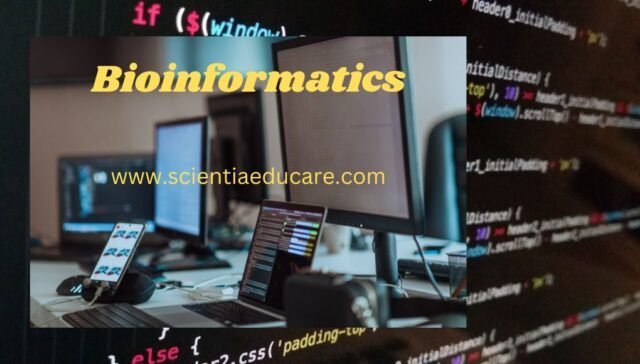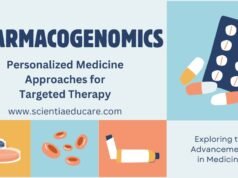Bioinformatics: Advanced Data Analysis and Computational Biology
Introduction to Bioinformatics
Bioinformatics is an interdisciplinary field that combines biology, computer science, mathematics, and statistics to analyze and interpret biological data. It plays a crucial role in genomics, proteomics, drug discovery, and systems biology by enabling researchers to manage and analyze vast amounts of biological information.
Bioinformatics Data Analysis, Bioinformatics and Computational biology,
Best bioinformatics software tools,
Computational biology applications guide,
How to analyze genomic data,
Bioinformatics for beginners course,
Machine learning in genetics
Key Components of Bioinformatics
Bioinformatics consists of various components that facilitate biological data processing:
- Genomics: Study of an organism’s complete genetic material.
- Proteomics: Analysis of protein structures and functions.
- Transcriptomics: Examination of RNA transcripts.
- Metabolomics: Study of metabolic processes.
- Systems Biology: Integration of biological data to understand complex interactions.
Bioinformatics Data Analysis
1. Collection and Storage of Biological Data
- Biological databases store genomic, proteomic, and structural data.
- Examples of widely used databases:
- NCBI (National Center for Biotechnology Information) [https://www.ncbi.nlm.nih.gov/]
- EMBL-EBI (European Bioinformatics Institute) [https://www.ebi.ac.uk/]
- UniProt (Universal Protein Resource) [https://www.uniprot.org/]
2. Sequence Alignment and Analysis
Sequence alignment helps in identifying homologous sequences and evolutionary relationships.
- Types of sequence alignment:
- Global alignment (Needleman-Wunsch algorithm)
- Local alignment (Smith-Waterman algorithm)
- Common tools:
- BLAST (Basic Local Alignment Search Tool) [https://blast.ncbi.nlm.nih.gov/]
- Clustal Omega [https://www.ebi.ac.uk/Tools/msa/clustalo/]
3. Gene and Protein Prediction
- Gene prediction algorithms analyze DNA sequences to predict genes.
- Protein structure prediction helps in drug design and functional studies.
- Tools for prediction:
- GENSCAN [https://hollywood.mit.edu/GENSCAN.html]
- Phyre2 [http://www.sbg.bio.ic.ac.uk/phyre2/]
4. Structural Bioinformatics
- Focuses on modeling and visualization of biological macromolecules.
- Tools and databases:
- PDB (Protein Data Bank) [https://www.rcsb.org/]
- Swiss-Model [https://swissmodel.expasy.org/]
Computational Biology: Algorithms and Techniques
Computational biology applies mathematical models, algorithms, and statistical techniques to biological questions.
1. Machine Learning in Bioinformatics
- Applications:
- Disease prediction and classification
- Drug discovery
- Genomic sequence analysis
- Popular machine learning tools:
- TensorFlow [https://www.tensorflow.org/]
- Scikit-learn [https://scikit-learn.org/]
2. Molecular Docking and Drug Discovery
- Computational techniques predict how small molecules interact with target proteins.
- Software for docking analysis:
- AutoDock [http://autodock.scripps.edu/]
- PyMOL [https://pymol.org/]
3. Systems Biology and Network Analysis
- Integrates data from genomics, transcriptomics, and proteomics.
- Tools used:
- Cytoscape [https://cytoscape.org/]
- KEGG (Kyoto Encyclopedia of Genes and Genomes) [https://www.genome.jp/kegg/]
Applications of Bioinformatics
- Genetic Research: Identification of disease-causing genes.
- Personalized Medicine: Tailoring treatments based on genetic profiles.
- Agricultural Biotechnology: Enhancing crop yield and disease resistance.
- Synthetic Biology: Designing biological systems for new applications.
Challenges and Future Perspectives
- Data Management: Storing and processing massive biological datasets.
- Computational Complexity: Developing efficient algorithms.
- Ethical Concerns: Privacy and security of genetic data.
- Integration with AI: Advanced machine learning models for biological insights.
Further Reading and Useful Links
- Bioinformatics.org [https://www.bioinformatics.org/]
- European Molecular Biology Laboratory (EMBL) [https://www.embl.org/]
- Nature Computational Biology [https://www.nature.com/natcomputsci/]
- Bioconductor for Bioinformatics Analysis [https://www.bioconductor.org/]
This study module provides a foundational understanding of bioinformatics and computational biology, highlighting essential tools, databases, and applications in biological sciences.
MCQs on “Bioinformatics: Data Analysis and Computational Biology”
1. What is the primary purpose of bioinformatics?
A) To study bacteria and viruses
B) To analyze and interpret biological data
C) To manufacture biological drugs
D) To create new species
Answer: B) To analyze and interpret biological data
Explanation: Bioinformatics combines biology, computer science, and mathematics to analyze large datasets, such as genomic sequences, protein structures, and metabolic pathways.
2. Which database is commonly used for storing nucleotide sequences?
A) Swiss-Prot
B) PDB
C) GenBank
D) KEGG
Answer: C) GenBank
Explanation: GenBank, maintained by NCBI, is a widely used database for storing and retrieving nucleotide sequences.
3. What is BLAST used for?
A) Comparing protein sequences
B) Storing DNA sequences
C) Predicting protein structures
D) Designing new genes
Answer: A) Comparing protein sequences
Explanation: BLAST (Basic Local Alignment Search Tool) is an algorithm that finds regions of similarity between sequences, helping in sequence alignment and functional annotation.
4. What does FASTA format represent in bioinformatics?
A) A method for growing bacteria
B) A file format for nucleotide or protein sequences
C) A type of genetic mutation
D) A sequencing technique
Answer: B) A file format for nucleotide or protein sequences
Explanation: FASTA format is a simple text format that stores biological sequences along with their metadata.
5. Which of the following is a key technique in structural bioinformatics?
A) Phylogenetic analysis
B) Molecular docking
C) DNA sequencing
D) RNA transcription
Answer: B) Molecular docking
Explanation: Molecular docking is used to predict how molecules, such as drugs and proteins, interact at an atomic level.
6. Which programming language is commonly used in bioinformatics?
A) Python
B) JavaScript
C) HTML
D) Ruby
Answer: A) Python
Explanation: Python, with libraries like Biopython, is widely used for bioinformatics due to its ease of handling biological data.
7. What is the role of computational biology?
A) Designing new computer hardware
B) Simulating biological processes and analyzing biological data
C) Producing new chemicals
D) Diagnosing diseases
Answer: B) Simulating biological processes and analyzing biological data
Explanation: Computational biology applies algorithms and mathematical models to understand biological systems.
8. Which tool is used for multiple sequence alignment?
A) BLAST
B) CLUSTALW
C) RASMOL
D) AUTODOCK
Answer: B) CLUSTALW
Explanation: CLUSTALW is a widely used tool for aligning multiple DNA, RNA, or protein sequences.
9. What is a phylogenetic tree?
A) A type of plant
B) A representation of evolutionary relationships
C) A database for DNA sequences
D) A method for DNA sequencing
Answer: B) A representation of evolutionary relationships
Explanation: Phylogenetic trees depict evolutionary connections among different species or genes.
10. Which algorithm is used in genome assembly?
A) Needleman-Wunsch
B) Smith-Waterman
C) de Bruijn graph
D) Hidden Markov Model
Answer: C) de Bruijn graph
Explanation: De Bruijn graph is used in short-read genome assembly for reconstructing sequences efficiently.
11. Which of the following is an example of a secondary protein structure?
A) Alpha helix
B) DNA strand
C) ATP molecule
D) Cell membrane
Answer: A) Alpha helix
Explanation: Secondary structures like alpha helices and beta sheets are formed due to hydrogen bonding in proteins.
12. What is transcriptomics?
A) Study of DNA sequences
B) Study of RNA transcripts
C) Study of protein structures
D) Study of metabolic pathways
Answer: B) Study of RNA transcripts
Explanation: Transcriptomics analyzes the complete set of RNA transcripts produced by the genome.
13. Which database stores protein structures?
A) PDB
B) GenBank
C) KEGG
D) EMBL
Answer: A) PDB
Explanation: The Protein Data Bank (PDB) stores 3D structures of proteins and nucleic acids.
14. Which machine learning method is commonly used in bioinformatics?
A) Linear regression
B) Neural networks
C) Decision trees
D) K-Means clustering
Answer: B) Neural networks
Explanation: Neural networks are widely used for predicting protein structures and gene expression patterns.
15. What is KEGG used for?
A) Storing gene sequences
B) Analyzing metabolic pathways
C) Identifying viruses
D) Protein folding simulations
Answer: B) Analyzing metabolic pathways
Explanation: KEGG (Kyoto Encyclopedia of Genes and Genomes) maps genes to metabolic pathways.
16. What is the full form of NCBI?
A) National Center for Biochemistry Information
B) National Center for Biotechnology Information
C) National Cell Biology Institute
D) National Computational Biology Institute
Answer: B) National Center for Biotechnology Information
Explanation: NCBI provides bioinformatics tools and databases for molecular biology research.
17. What is metagenomics?
A) Study of individual organisms
B) Study of environmental genetic material
C) Study of human diseases
D) Study of enzyme activity
Answer: B) Study of environmental genetic material
Explanation: Metagenomics analyzes genetic material from environmental samples without culturing organisms.
18. What is homology modeling in bioinformatics?
A) Studying homologous chromosomes
B) Predicting 3D protein structures based on known structures
C) Analyzing genetic mutations
D) Sequencing the human genome
Answer: B) Predicting 3D protein structures based on known structures
Explanation: Homology modeling predicts protein structures using similar known structures as templates.
19. What is the importance of SNPs in bioinformatics?
A) They store biological data
B) They help identify genetic variations
C) They are types of enzymes
D) They are involved in photosynthesis
Answer: B) They help identify genetic variations
Explanation: Single Nucleotide Polymorphisms (SNPs) are variations in DNA sequences that can influence traits and diseases.
20. What does docking simulation in bioinformatics predict?
A) DNA replication errors
B) Protein-ligand interactions
C) Cell division rates
D) Microbial growth
Answer: B) Protein-ligand interactions
Explanation: Docking simulations predict how molecules, such as drugs, interact with proteins.














